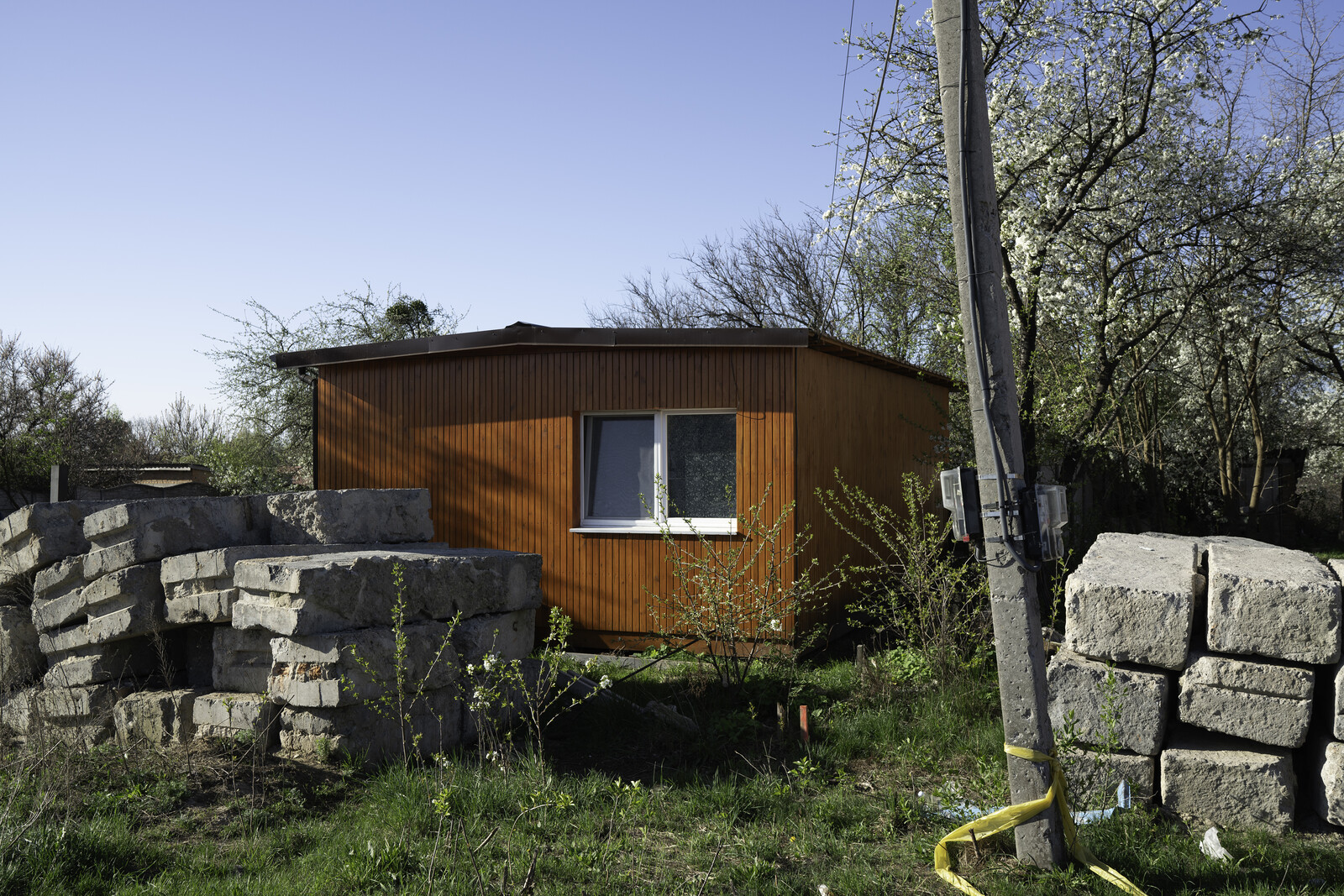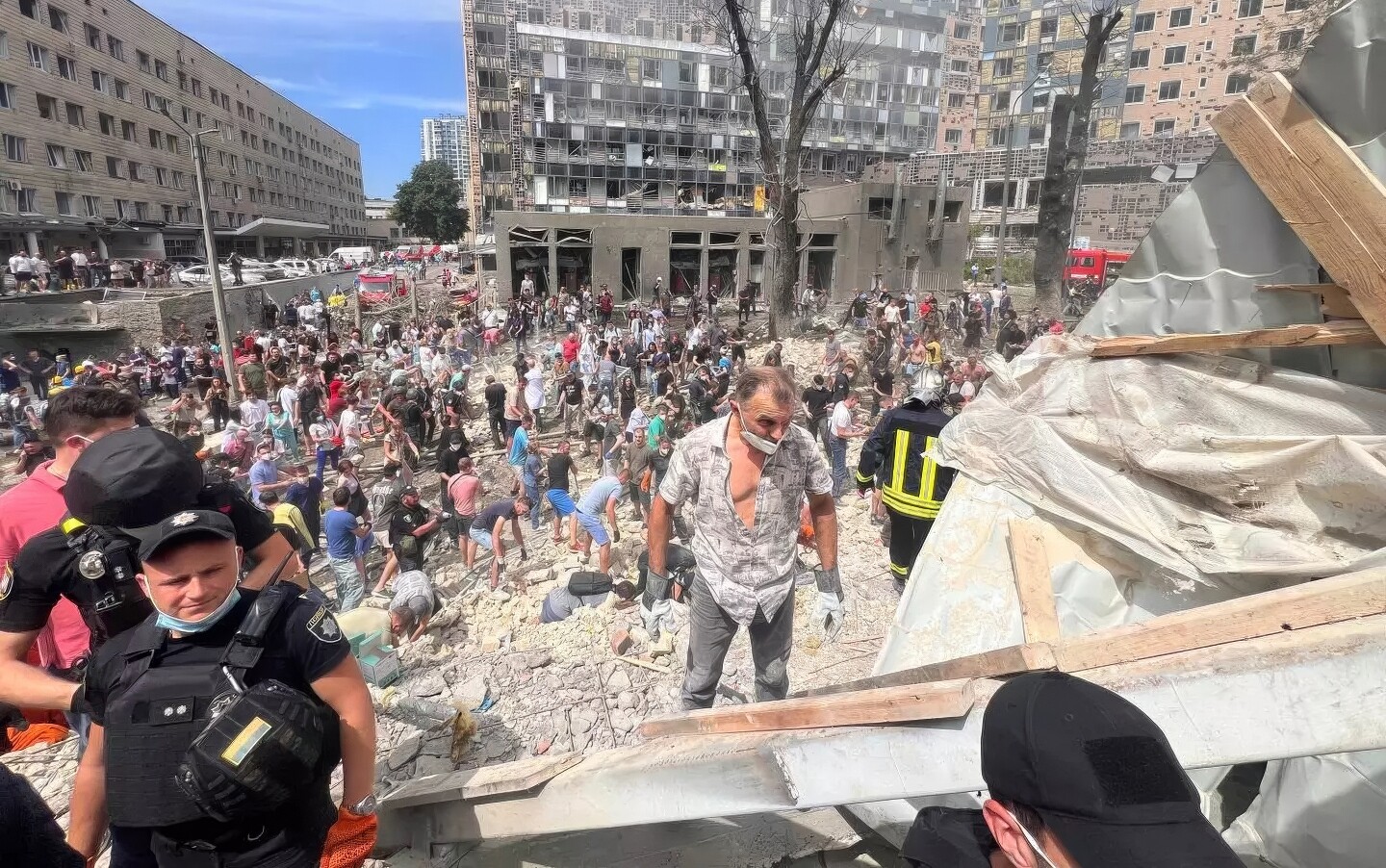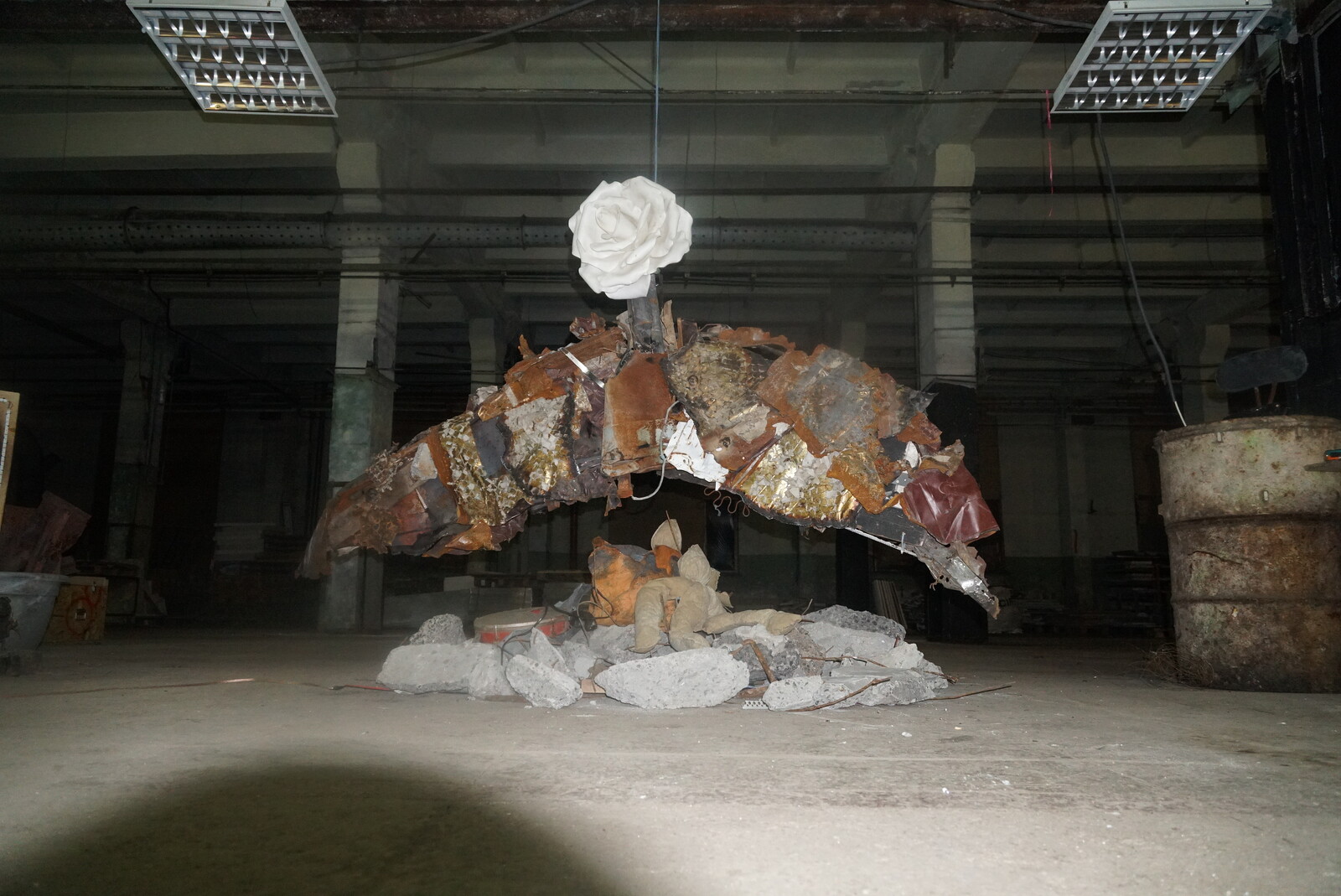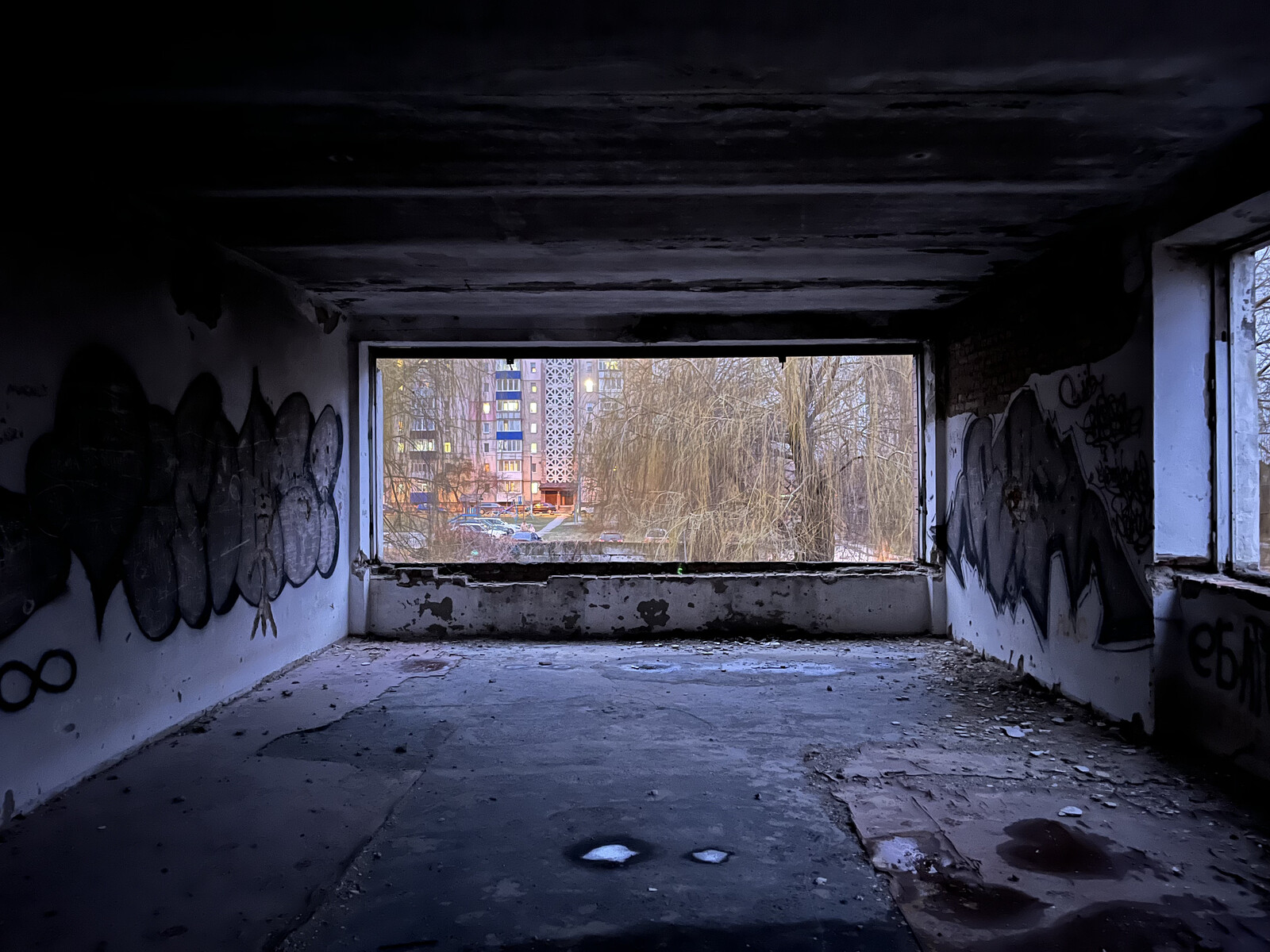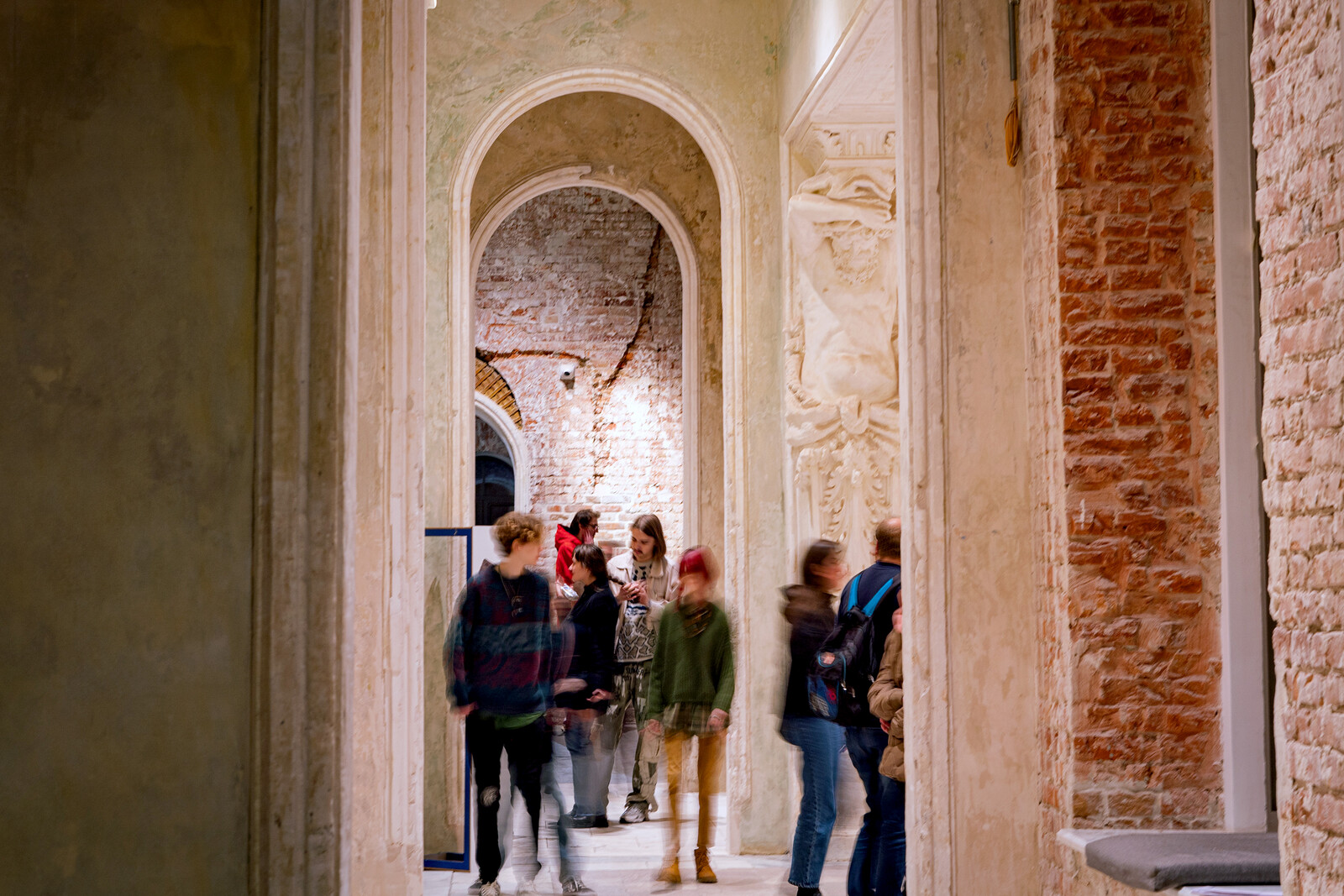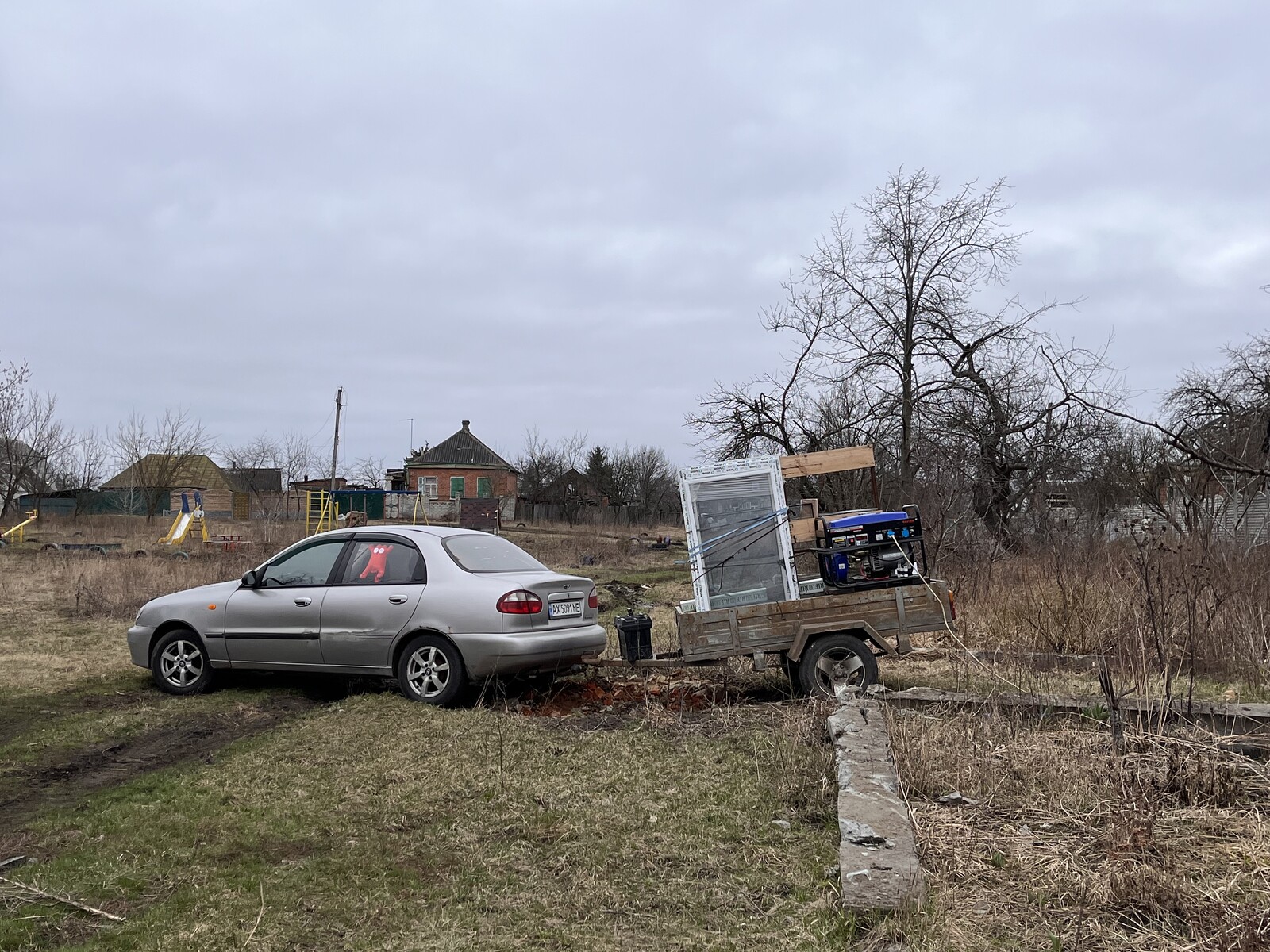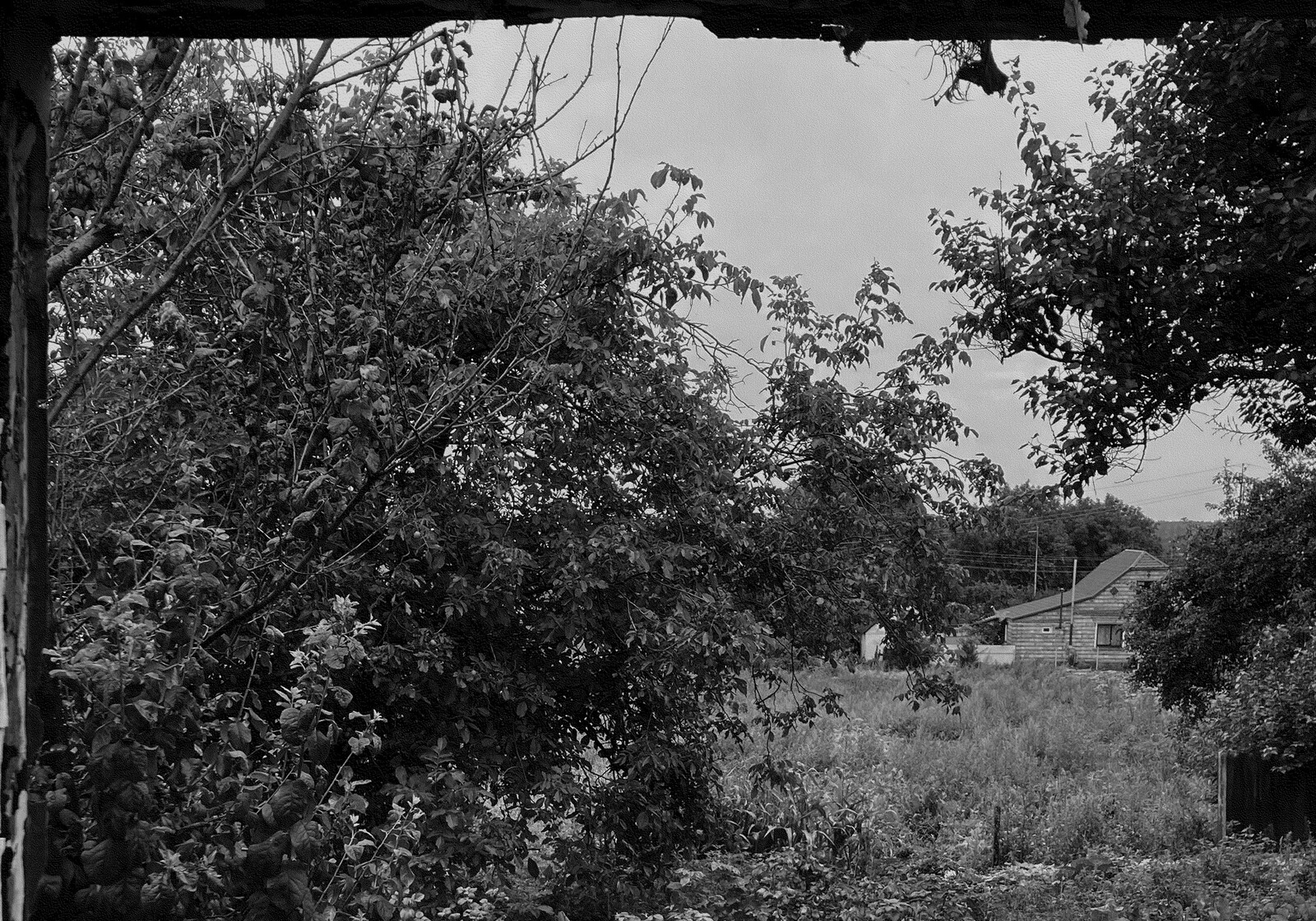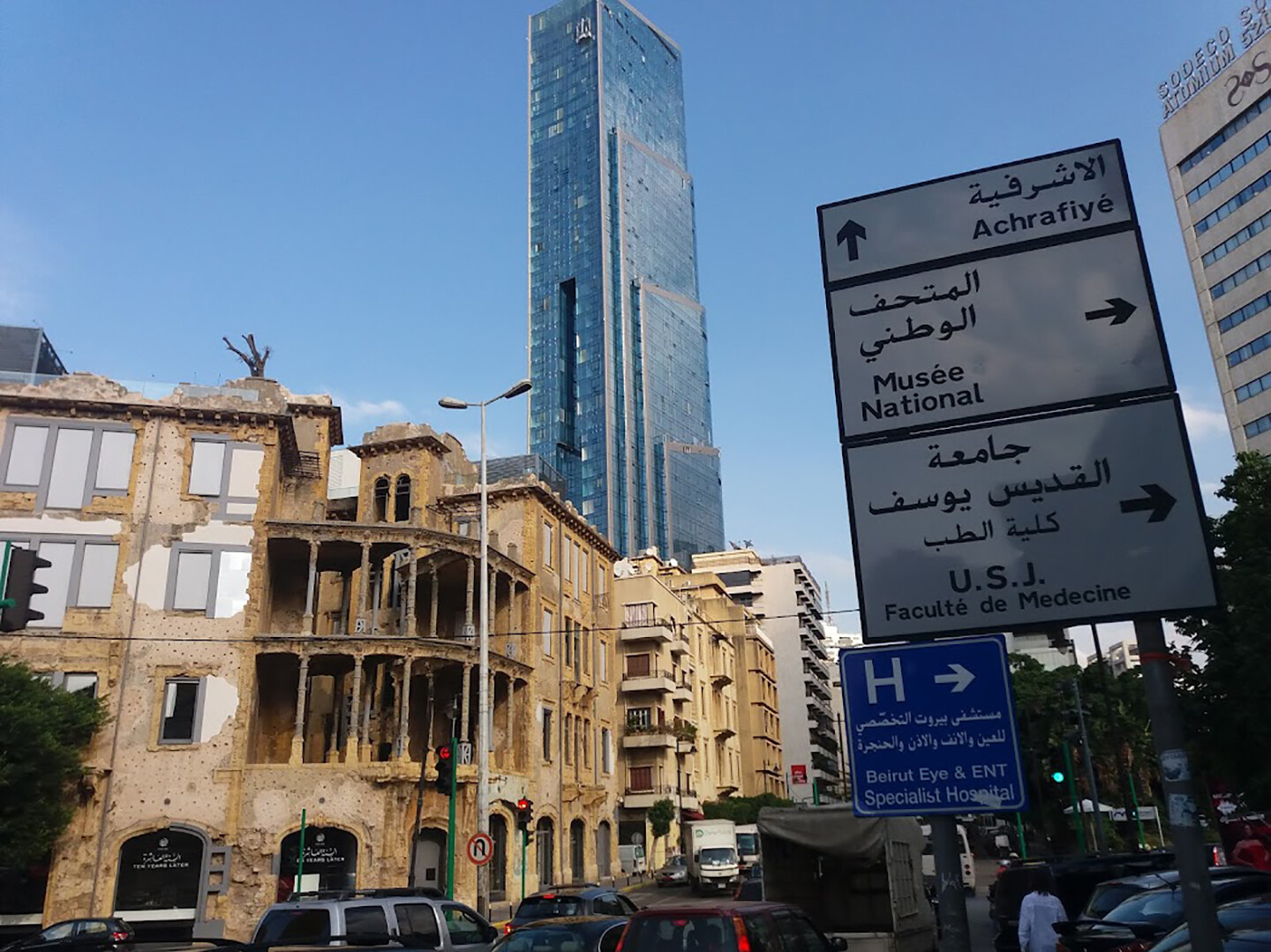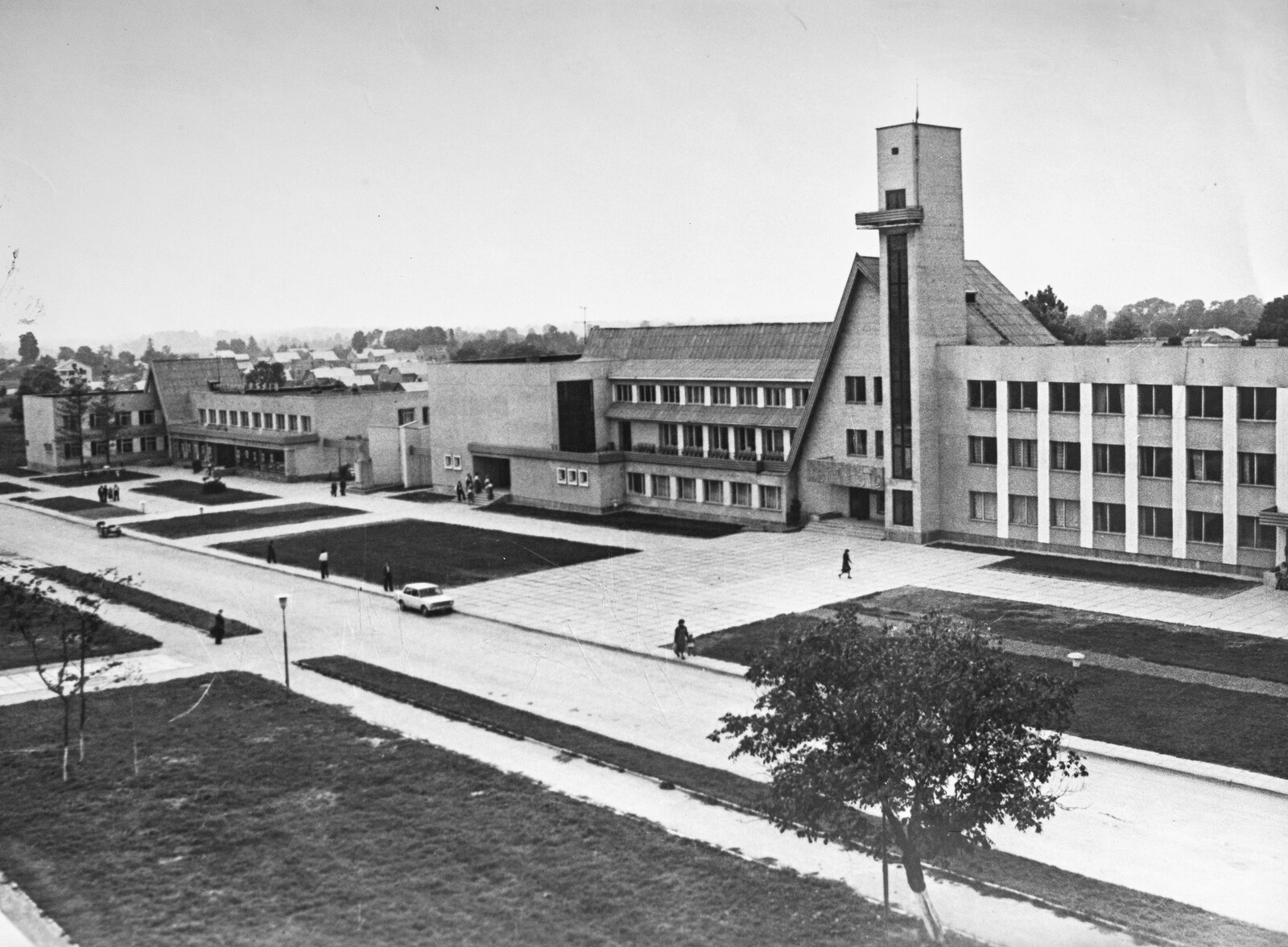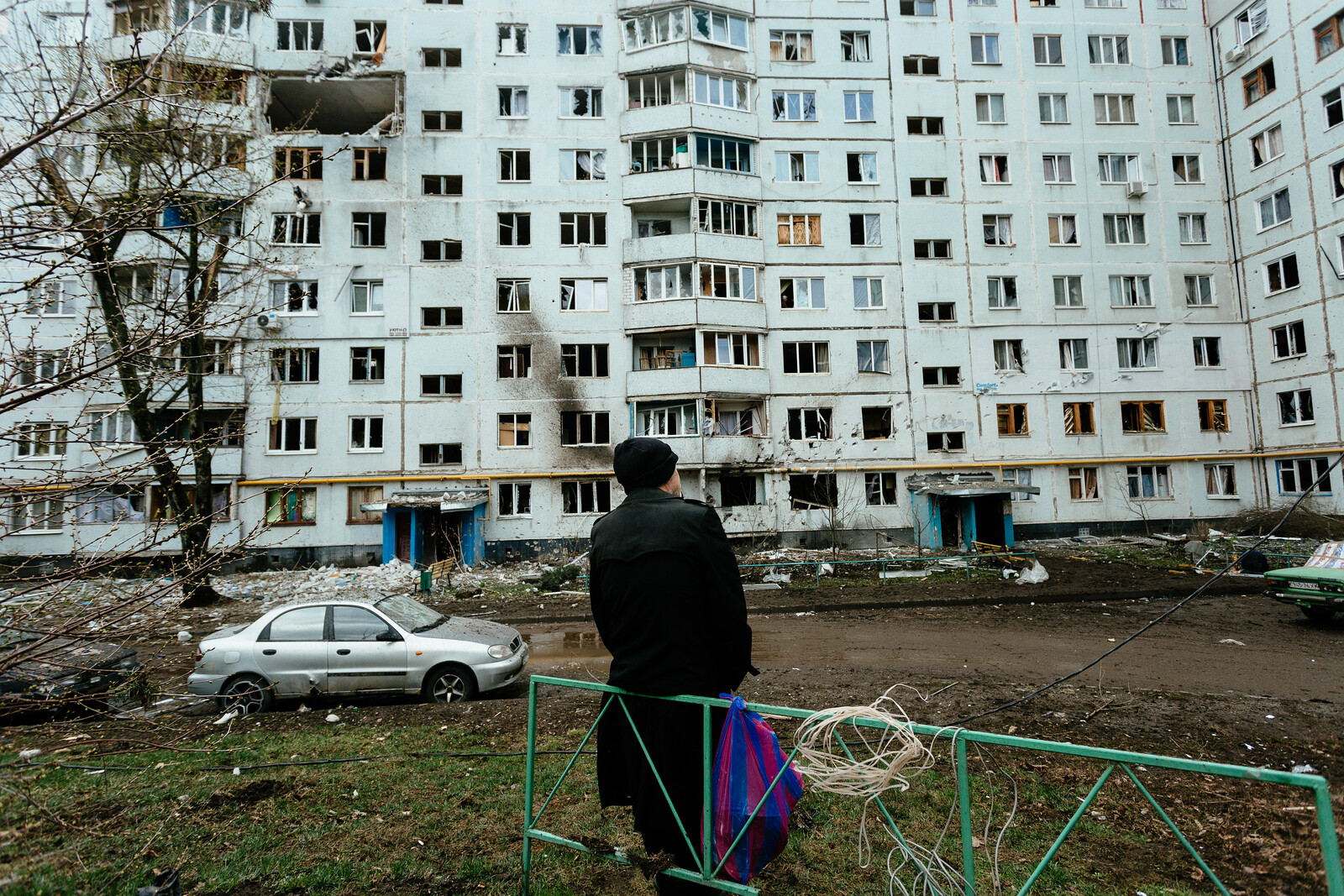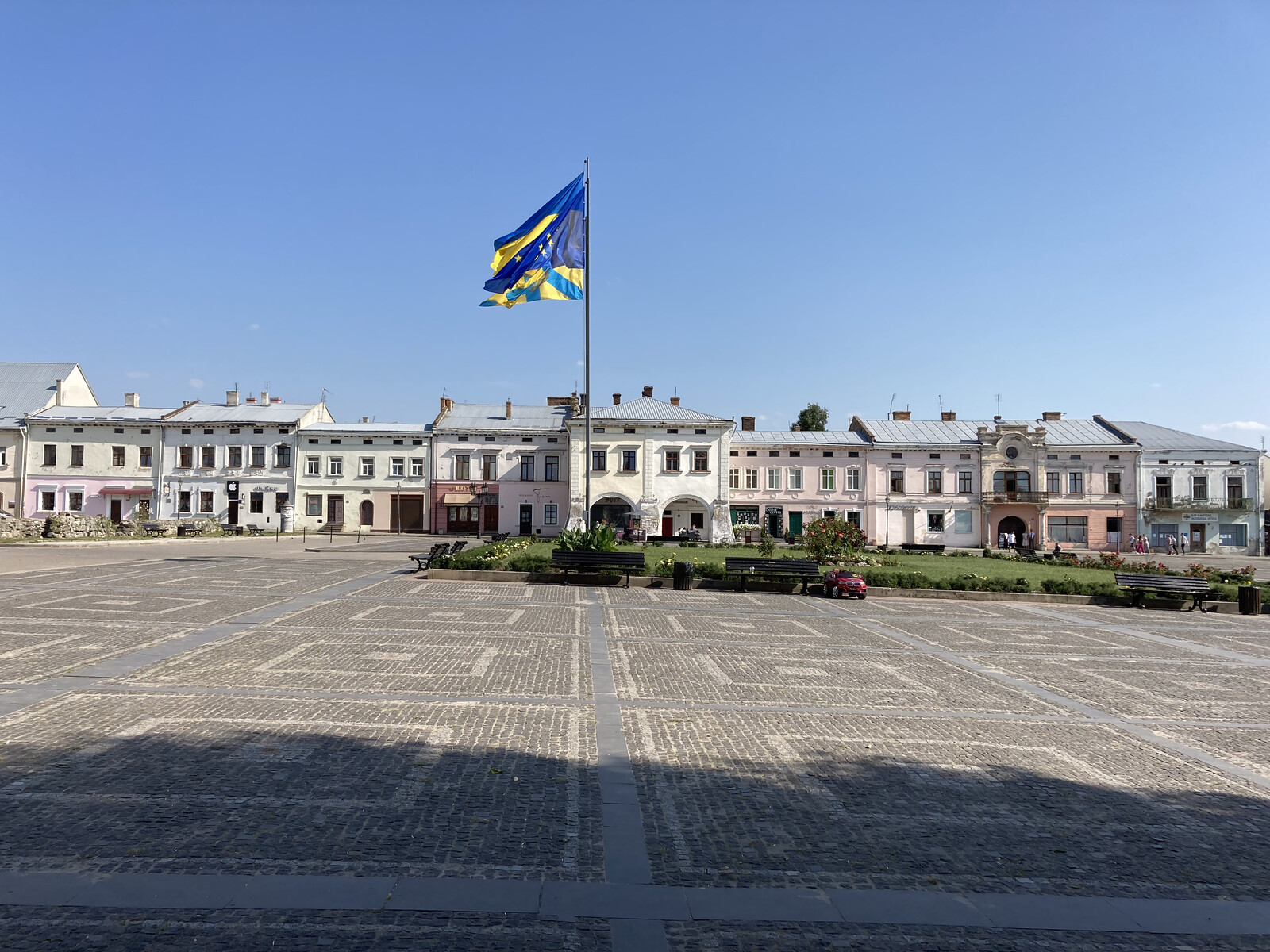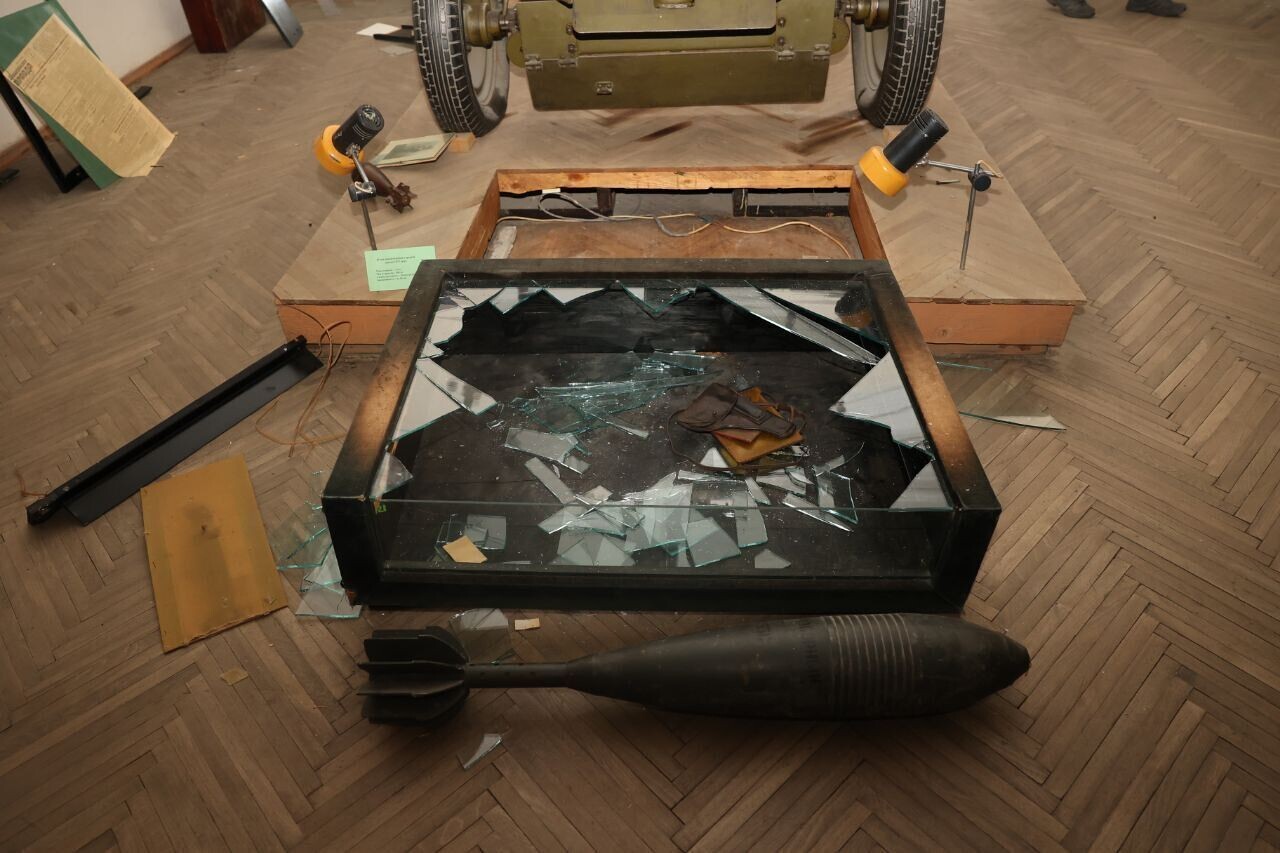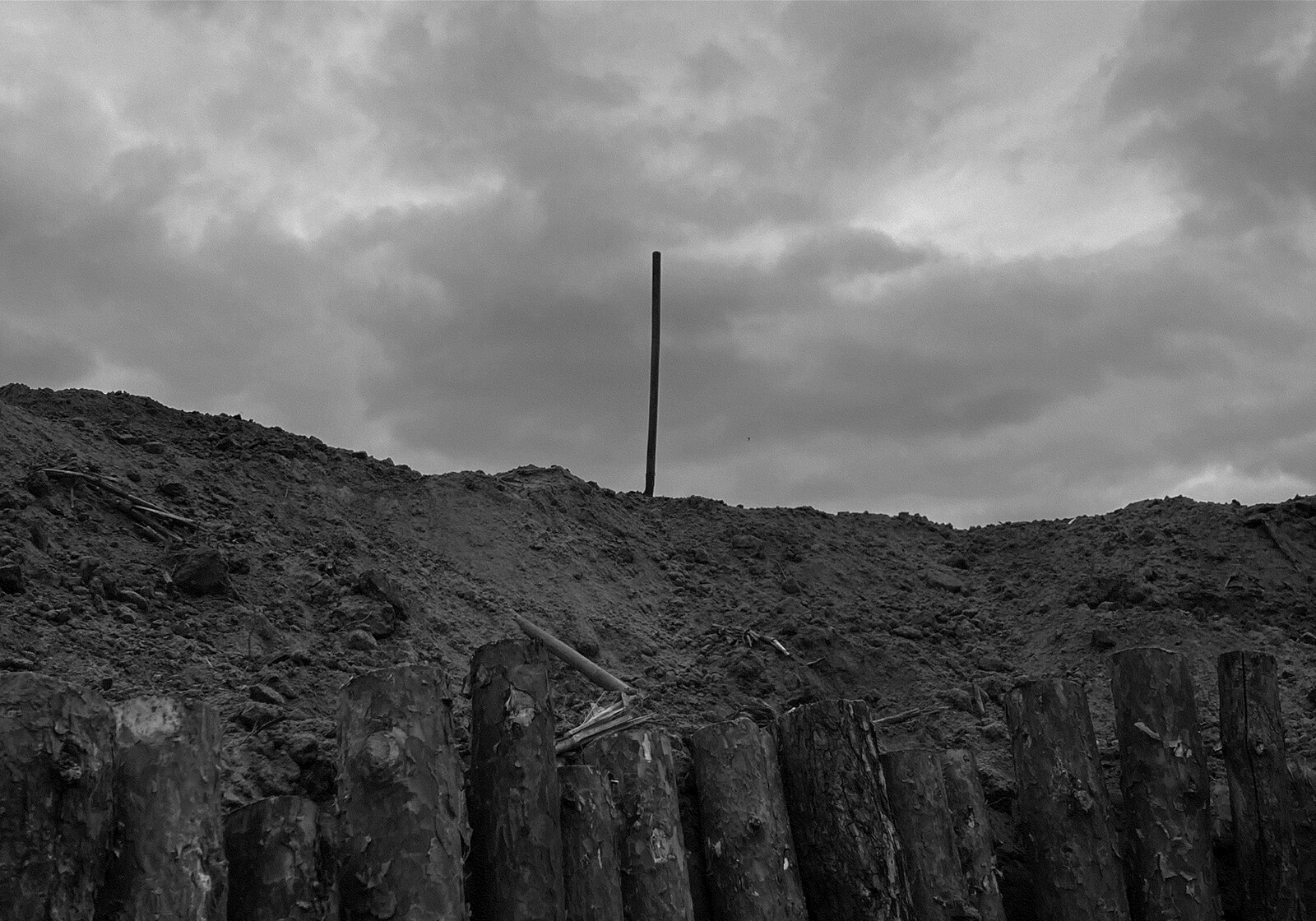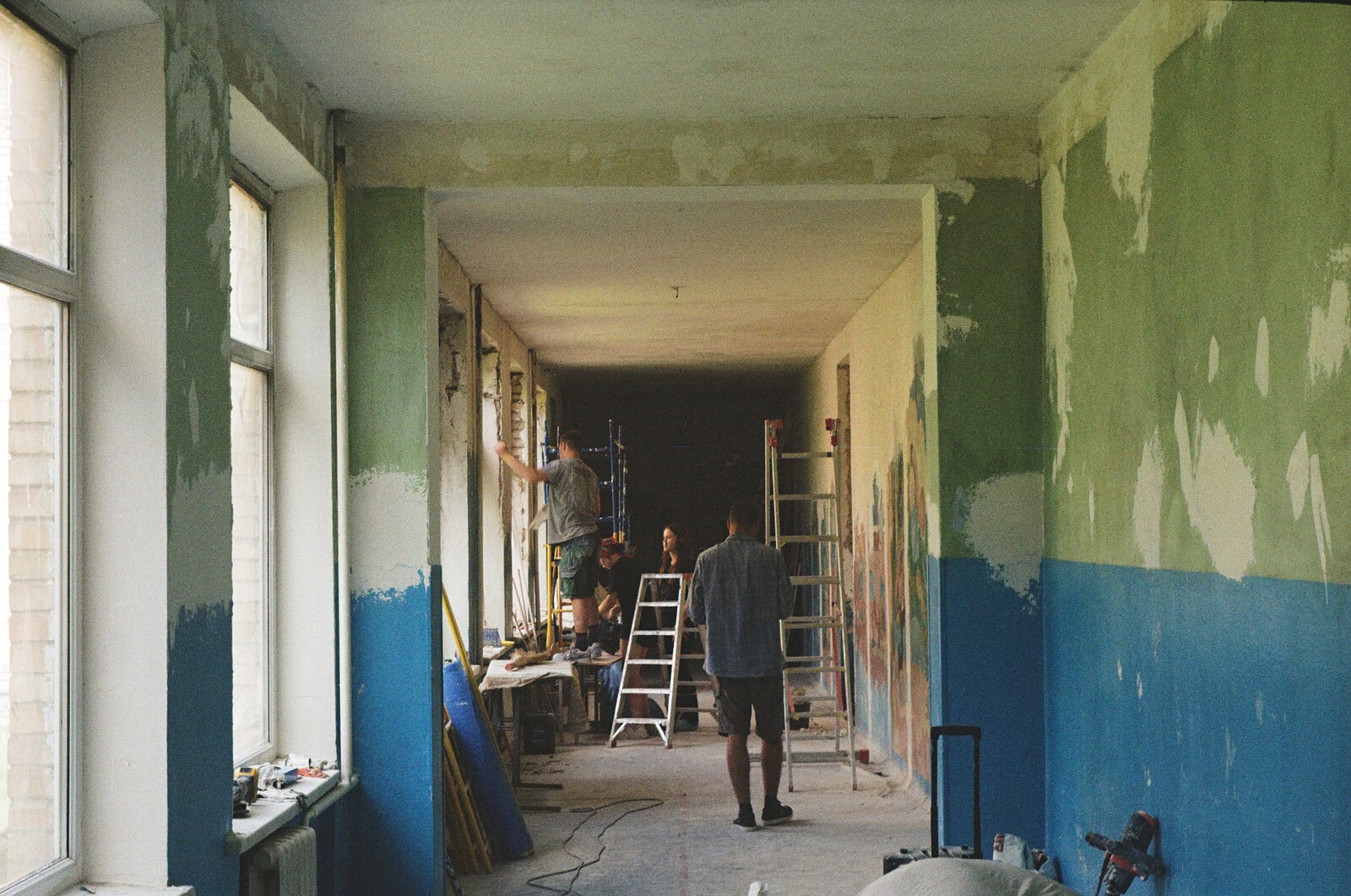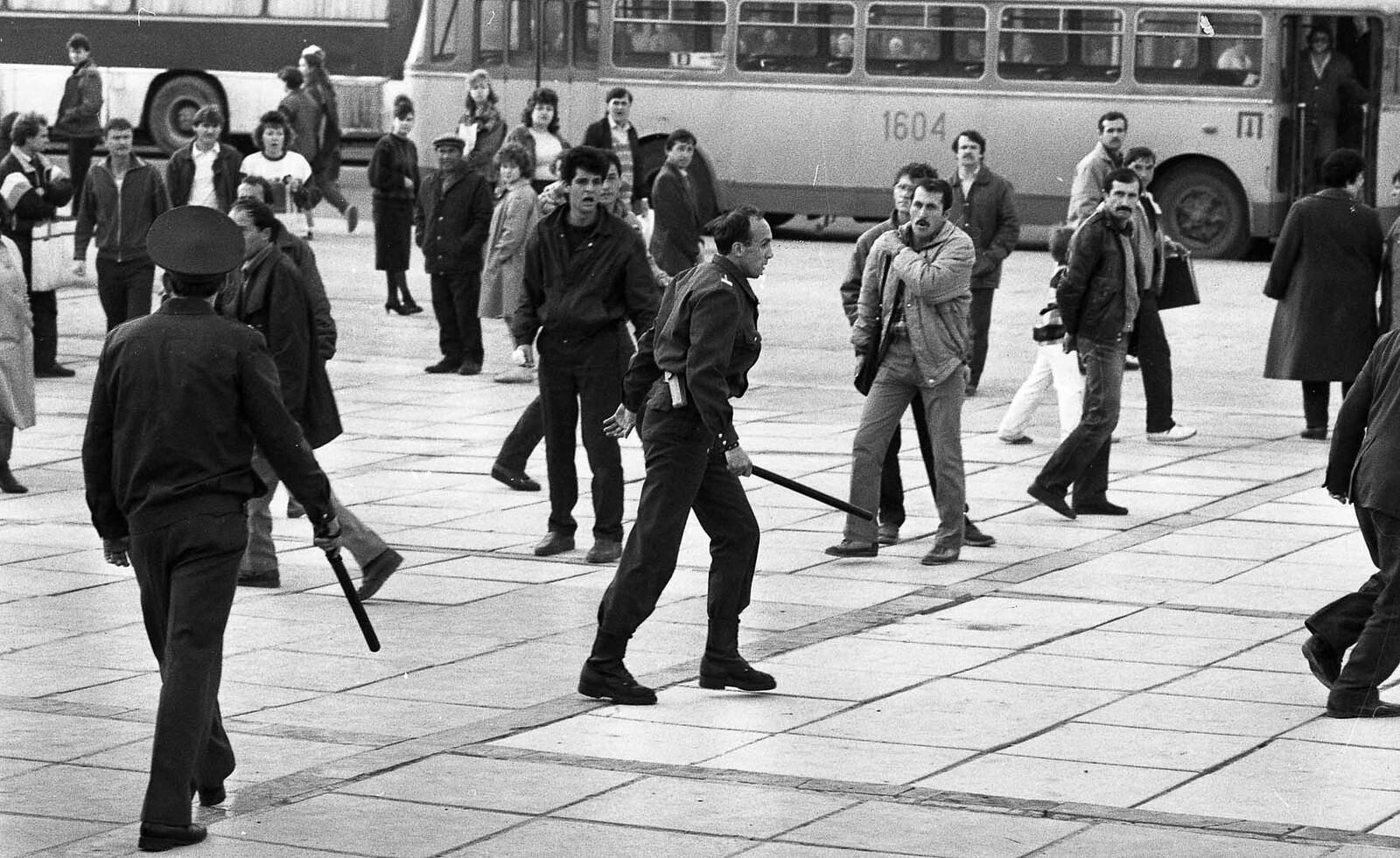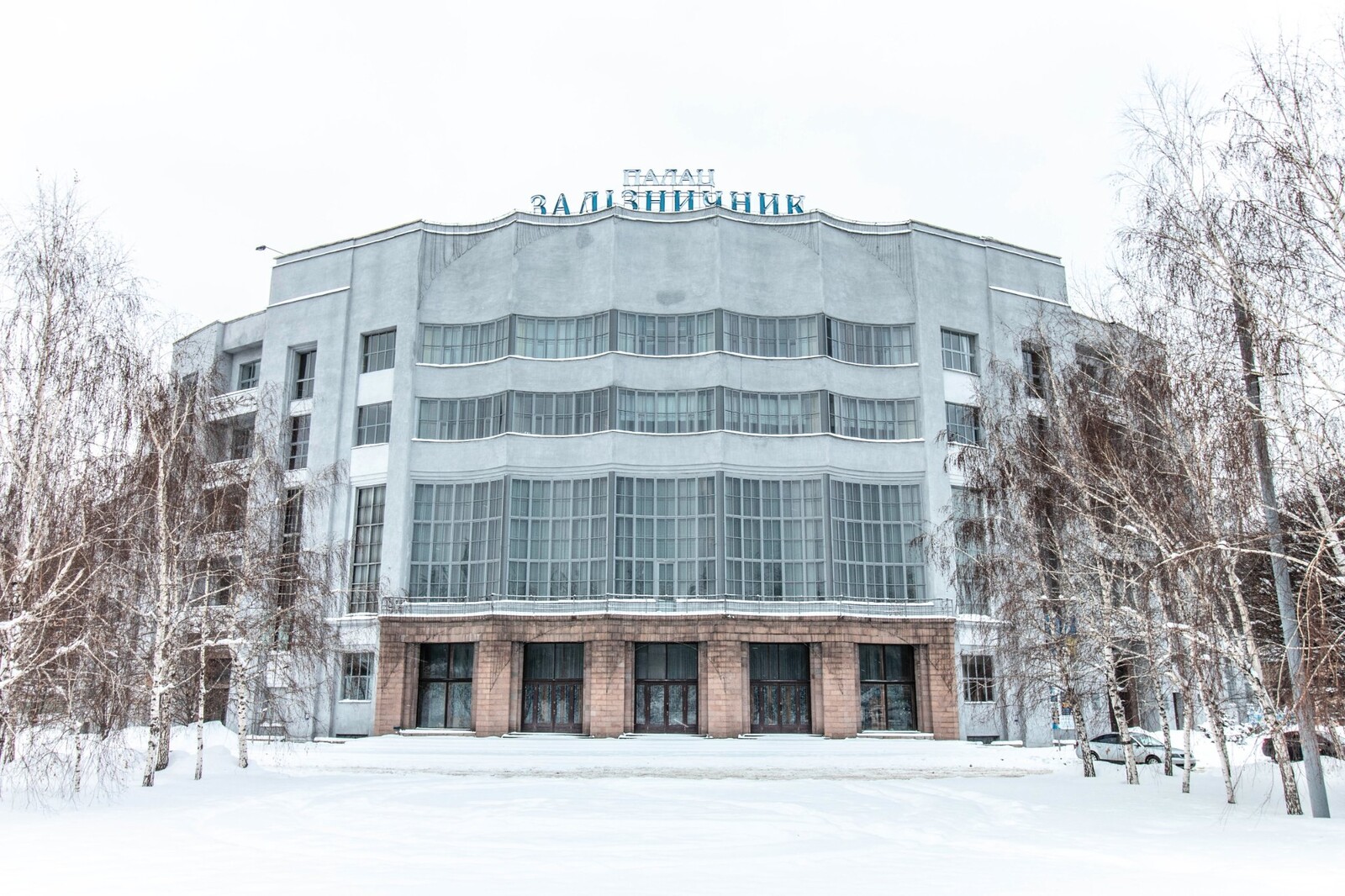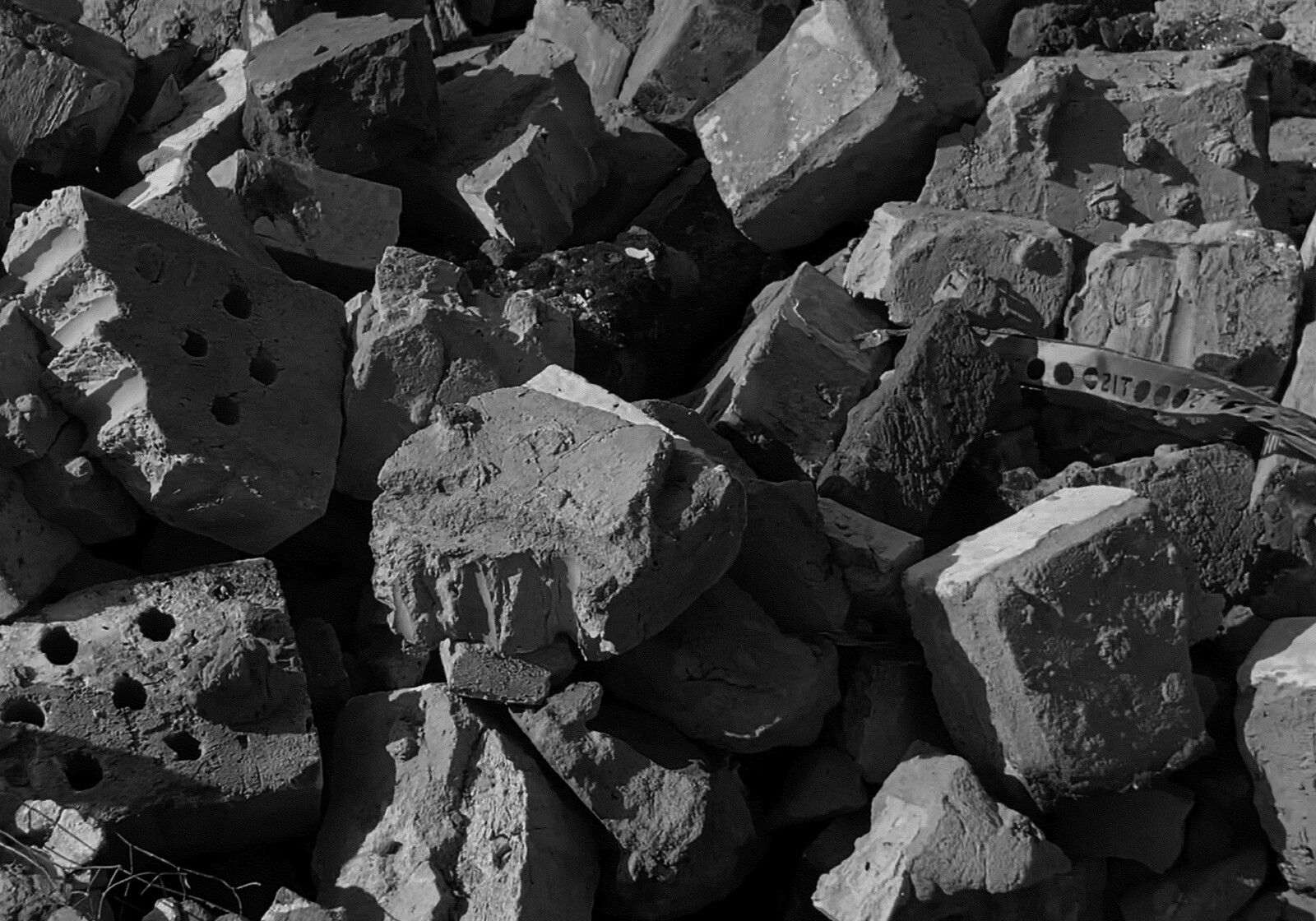In July 2024 I visited several prefabricated housing projects in Vinnytsia and Kyiv, Ukraine. It was hot, the middle of summer. Women were selling wild blueberries and honey by the side of the road. Air raid sirens wailed from time to time. I ate dinner outside in the humid evenings. Traveling into, around, and out of Ukraine, to the factory where the housing modules are built and to the region where the modules are delivered and installed, my thoughts kept returning to the theme of mobility, to the freedom to move.
Mobility framed my journey because travel in and out of Ukraine is limited; you cannot travel in or out by air, so train travel has taken on a new importance. It can be hard to find tickets, as they sell out early. Travel is severely limited for Ukrainian men between eighteen and sixty years old, who are not allowed to leave the country unless they manage to secure a hard-won pass for round-trip travel. My own family’s history, as Ukrainians from what is now the Polish border region, makes the issue of mobility especially poignant.
But this account of my journey is also about the housing modules themselves. More specifically, it is about how these modules are neither temporary nor permanent homes, neither short- nor long-term housing. What does it mean for housing to be medium-term? In other words: what occupies the space between crisis and regular life? What is it like to make a home in a country at war?
Medium-term housing and mobility kept appearing in my travels as intertwined themes. During wartime, people need stable homes and the freedom to move, to pursue their careers, families, and dreams. Both are part of the truth of the places I visited and the lives of the people I met. So how is it possible to guarantee some measure of permanence and mobility during war?
The module home project
In Ivaniv, a village outside the city of Vinnytsia in western-central Ukraine, I sat chatting with Pasha, the kind, talkative coordinator of the prefabricated module housing program. We were in the factory of Divario, a Ukrainian/Swiss lumber manufacturer, which, since the start of Russia’s full-scale invasion of Ukraine, has built houses for Ukrainians whose homes were destroyed under Russian occupation.
Divario is a subsidiary of the Swiss window manufacturer Huber Fenster. For almost twenty years, Divario has supplied small pieces of lumber, called scantlings, to Huber Fenster. These scantlings begin life as oak trees grown in a forest near Vinnytsia. During my two visits to Divario’s factory this year, I watched as timber was delivered to the factory, sawed into boards, dried, sorted, and glued to produce fine pieces of laminated scantling. Both men and women work on the factory floor, outfitted in simple Divario uniforms: a t-shirt and pants. Any trimmings from the manufacturing process are gathered and pressed into briquettes for wood stoves, which are exported to Germany and Switzerland. I lugged two of these briquettes back home with me to Berlin, where they filled my apartment with the fresh smell of oak wood. Since the autumn of 2022, local pine, deemed not fine enough for laminated scantling, has been used to build nineteen- and thirty-six-square-meter module homes.

Divario’s lumber begins life as oak and pine trees in a forest near Vinnytsia. Photo: Jonathan Banz.

Fine laminated scantling being produced by Divario for Huber Fenster. Photo: Jonathan Banz.

Denys, a foreman at Divario, builds a new module home for Ivankiv. Photo: Martin Huber.

Module construction underway at Divario’s factory in Ivaniv. Photo: Martin Huber.
Divario’s lumber begins life as oak and pine trees in a forest near Vinnytsia. Photo: Jonathan Banz.
I met Martin Huber, Director Emeritus of Huber Fenster, who now directs Divario’s module housing program, through Swiss German friends who research Ukraine. Martin and I first met in the airport in Chisinau, Moldova; I had flown there from Berlin via Rome, he from Zurich via Vienna. From Chisinau, Martin, three friends, a local chauffeur, and I drove to the Ukrainian border at Moldovan Otaci. We walked over the Dniester River into Mykhailo-Podilskyi. There I met Pasha, who drove us to the city of Vinnytsia.
The night I arrived in Vinnytsia for the first time, I barely slept. An air raid siren kept me up all night, and my first visit to the Divario factory was spent under a fog of extraordinary exhaustion and anxiety. It was only during my second visit that I could finally sit down with Pasha and the others to hear the backstory of the module homes.
Before Russia’s full-scale invasion of Ukraine, Divario employees had the chance to travel to Herisau, Switzerland every two years, to work and train at Huber Fenster. These days, only women can, and do, travel to Switzerland. But in February 2022, when the invasion began, two Divario employees, both Ukrainian men, were working in Herisau.
By day two of the invasion, Ivankiv, a hromada in Kyiv Oblast, was already under occupation.1 It would remain so for thirty-eight days. During those thirty-eight days, the newly elected mayor of Ivankiv moved from house to house, hiding from the Russian soldiers whom she was sure were looking for her.
Ivankiv’s hospital continued to function during this time, run by its head doctor Laryssa, a warm and intelligent woman. Laryssa told me that, during the occupation, Russian soldiers destroyed the area indiscriminately, shooting at random windows in random houses along the street. They did not destroy the hospital because, she said, they needed it in case their own men were injured.
On the outskirts of Vinnytsia, which was facing (and still faces) air attacks but was never occupied, the offices of Divario shut down. 2 After several weeks, and once the worst, most unpredictable days of the invasion were over, the director of Divario, Serhii Medvedchuk, gave the go-ahead to reopen the office. Not long after, Kyiv Oblast, including Ivankiv, was liberated from Russian occupation by Ukrainian forces.
Shortly after the liberation of Kyiv Oblast, Serhii was contacted by a childhood friend who serves as a director of business enterprises in the Chernobyl exclusion zone. This friend, like many of Divario’s employees, grew up in Ivaniv. (Ivaniv is a village in Vinnytsia, while Ivankiv is in Kyiv Oblast. It is hard to keep the two names straight. Pasha has assured me that the similarity in names is not why they set up the partnership.) He told Serhii that the Chernobyl community desperately needed emergency power equipment. Divario dispatched a team to deliver the equipment. On their way, they drove through the extraordinary devastation that had befallen Ivankiv, which borders the Chernobyl exclusion zone.3 In Ivankiv, some people slept in tents, some in the single room in their home that had not been destroyed, some with neighbors. Divario employees took photos of the devastation and sent them to Martin, who was in Herisau.
Meanwhile, Martin had been in talks with Uffer AG, a Swiss company specializing in prefabricated wooden module houses, about developing a housing module for Ukrainians who had lost their homes. A partnership with the village of Ivankiv, where the need for housing was urgent, and the mayor, Tetyana, who was open and motivated, made sense. Once a module blueprint had been developed, and the project proved feasible on the Ukrainian side, the two Divario employees already in Switzerland, along with Serhii and his brother, traveled to Uffer AG for training in module building. Serhii could travel to Switzerland because he was in Turkey at the beginning of the full-scale invasion and had not yet gone back to Ukraine. His brother could travel out of Ukraine because he had three children under the age of eighteen, which meant he was exempt from military mobilization. Had the other two Divario employees not been in Herisau at the beginning of the invasion, they would never have been able to travel out of Ukraine and undergo comprehensive training in wooden module building.
At Divario, Pasha recounted a story to me as we sat on a wooden deck destined for another home. The module home project now had a devoted workshop in the Divario factory, housed in a massive, airy, modern industrial space. The men who underwent training in Switzerland, Pasha told me, traveled back to Vinnytsia to train him and the others. The knowledge went from the Swiss builders to nashi khloptsi (“our boys”) in Switzerland, and then back to Ukraine.
In the autumn of 2022, module building began in earnest at Divario. The factory was smaller then and, for the first few months, all the work happened outside, in the sun, rain, and snow. In November 2022, after months of Russian attacks on energy infrastructure, massive blackouts hit Ukraine. They had to adapt to blackout schedules, which meant that they often had to work at night. During the day, there was almost no power. In July 2024, rolling blackouts had returned, yet they were not as severe as they had been before. This was in part because it was summer, but also because Divario had obtained its own generators. When employees lost power at home, they sometimes just went to the office.
After those rough first months, a new factory space devoted to module building was constructed next to Divario’s existing space. By then module building had been streamlined, was even quick. By July 2024, they had already installed one hundred homes in Ivankiv, to great fanfare from the local municipality and from the Swiss German press.4
Shortly before meeting Laryssa, the doctor in Ivankiv, I visited the hundredth house. The kind man who lived there, Victor, invited me in; he was still installing electricity and plumbing. Alongside the module home sat what was left of his original house, which he told me he would eventually rebuild. Like many recipients of Divario homes, the program allows Victor a comfortable place to live while planning for a longer-term future on his own property. In this way, Divario’s program fits into many current rebuilding projects in Ukraine focused on short- to medium-term solutions, so that people have a place to live now, or not long from now. Elsewhere in Ivankiv sat a large complex of temporary housing donated by the government of Poland, which once housed the internally displaced. The complex was empty. Very short-term solutions no longer seemed to help. The Divario housing modules sit somewhere between permanent and temporary housing: they embody the medium-term.
The villages we drove through in Ivankiv—Kukhari and Sukachi—were all peppered with Divario’s module homes. These rectangular wooden cubes, in different shades and grains of lumber, were instantly recognizable against the green grass, home gardens, colorful fences, and brick and cinder block houses that were in various stages of construction and disrepair.

Rectangular wooden cubes, in different shades and grains of lumber, sit in between homes in various states of construction and disrepair. Photo: Pascal Mora.

A module home between summer gardens. Photo: Martin Huber.

Some residents rebuilt their houses while living in module homes. Photo by the author.

Concrete fences in the local style, in front of a module home in a pale shade of wood. Photo: Jonathan Banz.
Rectangular wooden cubes, in different shades and grains of lumber, sit in between homes in various states of construction and disrepair. Photo: Pascal Mora.
Victor led me out of his house. He had a garden and kept bees. He asked if I wanted some honey to take home, but before I could even answer, he ran to his car, grabbed a bucket of honey, and pressed it into my hands.
Near Victor lives Oksana, another recipient of a module home. Oksana recognized Martin from an earlier visit. Like so many people I met on my trip, Oksana was kind and willing to talk. But while Victor radiated energy, Oksana seemed tired, downhearted. I introduced myself, asked how she was doing, what life was like in the module home. She told me that things were hard these days because there was no electricity—or, as you say in Ukrainian, zamykayut’ svitlo (“they are shutting off the lights”). She could not keep the refrigerator cold, and food was rotting. How was she supposed to cook meals? And it was only supposed to get worse in the winter. What were they going to do then?
Our own trip had already been affected by the blackouts. The night before, when we arrived at our rented cottage near Ivankiv around 10:00pm, the electricity had just gone out. The housekeeper led us through the cottage with a big flashlight. “See, this is life in Ukraine,” she told me. Then she quickly opened all the bedroom doors, pulled the curtains aside, and took our breakfast orders. Her resigned words contrasted with her extraordinary energy.
On my second trip to Ivankiv, I traveled with Martin, Marco, and Sandro. Marco works in the IT department at Huber Fenster, and Sandro is an architect who had worked on Martin’s house in Herisau. Marco was there for work; Sandro came along out of interest, after receiving Martin’s invitation. When we arrived at the cottage near Ivankiv, in an area called Velykiy Lis (“Big Forest”), it was Marco and Sandro’s first evening in Ukraine. That morning, they had been in Zurich and, in a few days, they would travel back.
The next morning, after we met Victor and Oksana and visited several other modular homes, we drove into the town of Ivankiv—the district seat—to meet with the mayor. Our translator, Olesia—the town’s German and English teacher—met us in the parking lot.
In the mayor’s conference room, we were greeted with chocolates, cookies, and presents. The mayor, Tetyana, introduced herself and gave each of us a hug. She asked after Martin’s wife and sons. They laughed, hugged again. We sat down at the conference table, where she, along with the head doctor, Laryssa, told us about their region and their experiences under occupation.
Martin had done this before—brought foreigners, mostly Swiss friends and colleagues, to the mayor’s office and to these Ivankiv villages. He wanted to show foreigners what much of Ukraine was really like—an extraordinarily warm and welcoming place you could visit, even now, during the full-scale war—and what Ukrainians have really undergone—the true terrors of Russian occupation.
I understood Martin’s argument to be, first, there is a need to rebuild now: people have suffered unimaginable tragedy and need somewhere decent to live; and, second, it is already possible to rebuild: Ivankiv residents were no longer under occupation and no longer experiencing wide-scale destruction. It was relatively safe there, and quiet. People had the time to rebuild, and they deserved more than temporary housing; they deserved homes. He was on a mission grounded in the idea of a “medium-term” solution. Martin’s mission was interesting to me because its two components might appear, at first glance, contradictory, but, in the end, they make sense. In Ukraine, normal life goes on. War does not mean armed conflict at all times and everywhere. But the country had and was still undergoing destruction, and this is why people needed help. Martin tried to show foreigners the Ukraine he knew, in a state of relative calm. Foreigners might then be more convinced to contribute to the mission of recovery amid tragedy. Foreigners—and it was men who seemed to be more easily convinced to travel to Ukraine—had the freedom to travel into and out of the country and see Divario’s work for themselves. But the reason they traveled to Ukraine—to see the effects of war—was precisely the reason why Ukrainian men could not travel, could not leave.
In conversations with friends, family, and colleagues, I found myself balancing two seemingly contradictory truths: the calm, the normality, and the terror and destruction. I did not want to settle on either side, for several reasons. If it is too normal, too calm, then rebuilding does not seem urgent. But if it is too terrible, then grassroots rebuilding efforts might seem pointless, because they are, by nature, small, piecemeal. People want to feel they are contributing to something that will stick. And, finally, I do not want my own travels to Ukraine to seem either pointless or reckless.
Most of all, Ukrainians who stay in their hometowns, who stubbornly contribute to their community’s resilience, deserve a safe, warm place to call home. But how warm will it be, come winter? The rolling blackouts, which affect every one of Ukraine’s oblasts, to varying degrees, provide another challenge that the module homes do not address.
Mobility and permanence
Back at Divario in Ivaniv the next day, three young Ukrainian men named Dmytro, Denys, and Pavlo kept me chatting on the factory floor, while Pasha, their boss, circled around us, joking that I would get his workers in trouble. Don’t worry, Denys told me, smiling, vin dobriy shef (“he is a good boss”).
That morning, when I arrived at Divario, Dmytro had been shy and soft spoken. But by later in the afternoon, near the end of the workday, he and his coworkers had become extroverted and chatty. It was a hot day and I kept wiping the sweat off my face.
“Do you know about TCK?” Dmytro asked me.
“No,” I answered him.
“It’s the office that catches men on the street and sends them to the frontline,” he said.5 “Did you hear what happened in Odesa? They are picking people up and bringing them straight to the frontline.”
I asked all three of them what it was like to live under the threat of mobilization.
“Well, we aren’t twenty-five yet,” said Denys.
“But,” I thought to myself, “they must be turning twenty-five soon.”
Pavlo said he had never thought about it much until he had to register and was forced to think about it.
All three young men, Dmytro, Denys, and Pavlo, worked full-time building module homes. All three had grown up in the village of Ivaniv. One, Denys, had worked in Germany. They seemed frustrated by their inability to travel, particularly to Herisau, where they otherwise would be guaranteed a trip every two years. Part of the attraction of working at Divario was that its work was done, as Denys told me, on a “European” level. That is, the company looked westward, in its practices and its promises of international training. Working at Divario on building modules allowed them, even during wartime, to achieve career growth. Denys, for instance, had gone from worker to foreman. Still, Dmytro said that his life had been limited by the war. He hoped that, in the future, he could travel down to Ivankiv, to see his work installed there.
As I imagined Dmytro in Ivankiv, meeting Victor, Oksana, and others, I thought about the connection between his desire for mobility and their need for permanence: that both were taken away by the war. And the longer the war continued, the more these needs would press on their everyday lives.
A week later, my thoughts returned to mobility as I, an American woman, traveled across the border from Ukraine to Poland. My train was delayed for hours as border guards reviewed the documents of all men present between the ages of eighteen and sixty. In my compartment alone, two men were taken off the train, not allowed out of Ukraine. Their families went with them; they got off at the border station at twilight. Soon after, we pulled into the station in the Polish border town of Przemysl.
Over a century ago, my great-grandfather Mykola and his three brothers, Vasyl, Yuriy, and Andriy, left their village in the Beskid mountains in what is now eastern Poland to study in Przemysl, then a mostly Ukrainian-speaking town in the province of Galicia in what was then the Austro-Hungarian Empire. At that time, there was no nearby border. But like Dmytro, Denys, and Pavlo, Mykola and his brothers pursued their career ambitions, their mobility limited by the changing political situation. Vasyl was killed by Polish soldiers during the Polish-Ukrainian War of 1918–1919. Mykola, a railway worker, raised my grandfather in Buchach, Drohobych, and Stanislaviv (now Ivano-Frankivsk), all in today’s Ukraine. Yuriy became a Greek Catholic priest, married, and had children. He lived in Kryvche, north of Chernivtsi, at the beginning of the First World War. After the war ended, once he and his family could move again, he lived out the remainder of his days in Zhovkva, north of Lviv. Andriy, the oldest brother, became a teacher and settled near Sanok, in what is now Poland. None of the brothers lived long enough to see their Ukrainian descendants, living in what had become communist Poland, forcibly “repatriated” by the Polish government to Soviet Ukraine between 1944 and 1946.6 By the late 1940s, their ancestral lands in the Beskid mountains had disappeared. There was no longer any home to return to. They were forced to make their homes elsewhere.
A hromada is a small administrative region in Ukraine.
Vinnytsia, a quieter region of Ukraine during the full-scale war, suffered one of its most devastating missile attacks in July 2022. Twenty-nine people were killed, including three children, and over 200 injured, in an attack on downtown Vinnytsia, when, as Sasha, a Divario employee told me, kids were just playing outside in the middle of the day. The attack is currently under investigation as a war crime by the International Criminal Court. See: Katya Gatsenko, “‘Я сіла біля візочка і почала кричати’: річниця російського ракетного удару по центру Вінниці, де загинули 27 людей, із них троє дітей,” Radio Svoboda, July 14, 2023, ➝; Daniil Ukhorskiy, “Opinion: Landmark case could bring justice for Vinnytsia victims and transform international law,” Kyiv Independent, July 18, 2024, ➝.
As the residence of many Chernobyl workers, Ivankiv was heavily affected by the Chernobyl disaster; 22,810 Ivankiv residents are officially considered Chernobyl victims according to “Ivankivshchina: the Pearl of the Polissia Region,” a brochure by the Ivankiv settlement council.
See: Peter Hossli, “Herisauer baute 100 Häuser mitten im Krieg,” Blick, June 13, 2024, ➝.
TCK and SP (ТЦК та СП), Terytorialniy tsentr komplektuvannia ta sotsial’noyi pidtrymky, or the Territorial Center of Procurement and Social Support, is the Ukrainian military organ in charge of recruitment and accounting of all military personnel.
See Timothy Snyder, The Reconstruction of Nations (New Haven: Yale University Press, 2003); Maria Pajuga, “Сльози та цілування землі. Чому лемки з Прикарпаття їздять у далеке польське село,” ПІК, May 17, 2020, ➝.
Reconstruction is a project by e-flux Architecture drawing from and elaborating on Ukrainian Hardcore: Learning from the Grassroots, the eighth annual Construction festival held in the Dnipro Center for Contemporary Culture on November 10–12, 2023 (2024), and “The Reconstruction of Ukraine: Ruination, Representation, Solidarity,” a symposium held on September 9–11, 2022 organized by Sofia Dyak, Marta Kuzma, and Michał Murawski, which brought together the Center for Urban History, Lviv; Center for Urban Studies, Kyiv; Kyiv National University of Construction and Architecture; Re-Start Ukraine; University College London; Urban Forms Center, Kharkiv; Yale University; and Visual Culture Research Center, Kyiv (2023).
Category
Subject
The author would like to thank Amina Lysenko and Anastasiia Medvedchuk for their help and kindness.
